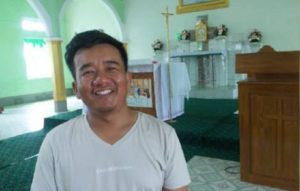«The parish of Tananukwe includes five villages and a population of 560 families. The majority of the people in this area are Christian, with a strong Catholic presence». Father Pius Kyan speaks to Agenzia Fides in Italian while showing the small church of Santa Teresa where he has been carrying out apostolic service for four years. He manages a thriving and numerous Catholic reality in the region a few kilometers from Loikaw, capital of the Burmese State of Kayah, where two-thirds of the population is Christian and where Catholics are an important presence: just by looking at the landscape, full of churches and chapels, more common than pagodas and mosques. «Our relations with all the other religious communities are good and based on dialogue», says the parish priest.
 Covid-19, although the State of Kayah has not registered a single case of Coronavirus (less than 350 across the country, with six deaths), is still an emergency and the guard is held high: «We celebrate mass with only five faithful at a time, to respect the rules imposed by the authorities, to avoid gatherings. A few days ago I went to a funeral, but only to give a blessing to the body and give spiritual comfort to the family. I visit the villages every month but then I only move in emergencies such as to give the last rites».
Covid-19, although the State of Kayah has not registered a single case of Coronavirus (less than 350 across the country, with six deaths), is still an emergency and the guard is held high: «We celebrate mass with only five faithful at a time, to respect the rules imposed by the authorities, to avoid gatherings. A few days ago I went to a funeral, but only to give a blessing to the body and give spiritual comfort to the family. I visit the villages every month but then I only move in emergencies such as to give the last rites».
Ordained a priest in 2012, Father Pius, 38, studied in Monza, near Milan: «A year to learn Italian and then four years of theology … a struggle. I wouldn’t mind going back to Italy to have a pastoral experience outside Myanmar. But I don’t want to go to a big city. I like places like this, where it is possible to have a direct relationship and a truly personal relationship with the faithful». Behind the church, there is a school, with its small campus, a volleyball field, and 17 students who receive the support of the parish, otherwise, they could not afford their studies. «We are also building a new church now», he says.
On the local situation, he notes that activities have stopped since April even though the lockdown has slowly eased. In fact, some villages have refused to finish it and remain closed to outsiders and tourists even if the Ministry of Tourism has given the green light. In a landscape marked by fields of rice, sesame, corn, vegetables, the area of the parish is known for the villages where the so-called «giraffe women» live, who, since they were children, wear rings around their necks that rest on their shoulders and lower the ribcage, lengthening the neck. It is a practice of indigenous culture that missionaries have fought hard and that has now fallen into disuse in Christian villages. The custom survives in the most remote areas, animism remains strong, which is expressed here with long wooden totems and funeral mounds where family members deposit, next to the tombs, food and drinks to accompany the journey of the deceased.
Between history and legend, the efforts of the first missionaries are narrated: one of these has even become a theatrical piece that tells of a missionary locked up in a pigsty by those who for the first time see a white man, with a beard and shoes on his feet. When man eats the food of animals by hunger and takes off his shoes, the natives finally discover that he is a human being like them, and fears fall. The paradigmatic story of the missionary adventure of the pioneers serves to recall the difficulties, the sufferings, in some cases martyrdom. And in the history mimed in the theater, it offers a sign of hope and a feeling of gratitude to those who brought the seed of the Gospel to Loikaw with missionary courage and enthusiasm.



